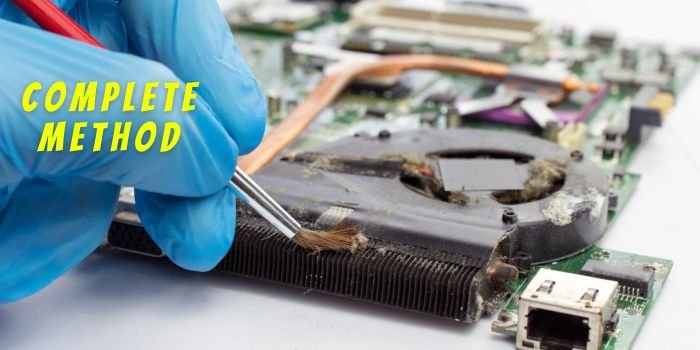Does your laptop feel like a Boeing 747 taking off, especially during heavy loads or are you simply dealing with unnecessary overheating that could possibly cook the salmonella out of an egg?
Nonetheless, in both circumstances, it’s about time that you consider your laptop cooling fans to have gone completely bonkers and you might want to rectify the situation before your whole system goes haywire.
In this article, I will demonstrate a step-by-step guide on How to Check if a Laptop Fan is Working Properly and how to remedy such a situation and throw a couple of tips along the way.
Signs Your Laptop Fans Are Probably Out Of Order
In order to diagnose your cooling system and identify whether or not it’s head over heels, here are 6 apparent ways you can follow.
1. Diagnosing Fans
A whirring fan makes a noise. You know that bit, don’t you? Consider the last time you watched a movie with a helicopter and how much noise it made. Well, your laptop fan won’t do that, but you’ll still hear a faint whirring sound.
- Turn on your laptop and wait for a few moments before you put your ear to the side where the fans are located.
- Don’t worry if the fans do not start immediately because they are only required when the laptop starts heating up.
- If you don’t hear them even after starting the machine, run a heavy program and after a few seconds, try hearing the sound such as a High Res Game or video editing software.
If you hear the fans, then rest assured, they are working. However, notice the quality of the sound.
- Is the sound cracking?
- Do you hear a lopsided fan noise?
- Do you feel as if something is stuck and making a weird sound?
Ask yourself these questions because the sound of a laptop fan is always smooth and uniform. Any irregularity in that should mean that you need to get it checked or tuned up.
2. Check Vents & Exhausts
I want you to feel the fans physically first before going to do any drastic measures. This includes feeling the air coming out of the vents with your bare hands.
- After you’ve turned on your laptop and run a heavy program, put out your hand in front of the vents, you should feel a faint warmth.
- If not, then hold a thick piece of paper or cloth in front of the vents just to be sure that it’s not faint enough. You should see the paper or the cloth move slightly.
- No luck? Follow step 3.
3. Temperature Monitoring
The first two methods were mainly physical. This one involves using software known to dig deeper into your laptop’s hardware and bring out all the information.
The software may be paid or free. However, they do work and remove any technicality from your way. So, if you feel a technological challenge, you may want to opt for the software.
I recommend using HWMonitor, SpeedFan, and RealTemp for Windows and iStart Menu for Macs.
Using the software is entirely easy as you only have to follow certain steps to see the information listed right before your eyes. As I said, this method is far superior.
But if you don’t want to use any of these, there’s also a Windows-based method mentioned below.
4. Press F12 At the Startup
- Turn off your laptop and disconnect all the devices.
- Turn it on again but press F12 repeatedly at the start.
- You will be taken into the diagnostics of Windows where you could check the speed of your fans and get an idea of whether they’re working or not.
Remember that you can still access Windows Diagnostics from the Start menu but to run this, Windows will ask you to restart your machine.
5. Look for Errors That Indicate Fan Problems
Whenever your laptop’s going through something and you don’t know what, always look for the signs. For example, when the fans are not working and your system is overheating, you could see a potential Blue Screen of Death.
Or, even if the fans are working, there could be an issue with the heat sink or any other part of the cooling system. The system may even heat when the thermal chemical that sits between the CPU and the heat sink or cooling system is damaged.
6. Keep Checking the Temperatures
Even if the fans are working, but the temperatures are still soaring, that could mean a potential motor problem.
Try Downloading any third-party temperature monitoring software mentioned above to check your system temperature.
Anything above 130 degrees is no doubt a red flag especially when you aren’t even doing anything, then that should notify you about whether the fans are out of order.
How to Deal With Overheating Issues Before Taking Laptop to Support?
Before you decide on taking your laptop to support, you want to troubleshoot the overheating problem by following these steps:
1. Clean the Vents
Dust and debris are the topmost nemesis of overheating or cooling disorders as air is flushed in and out of the vents, these pesky particles tend to clog up the vents causing malfunction or abnormalities.
Try removing the battery of your laptop to ensure there is no electricity running into the circuits because the last thing you would want is to run into any electrical hazards or short circuits.
Now flush compressed gas into the vents until they are squeaky clean, you can even use cotton buds to scratch off any grease to thoroughly clean your vents.
2. Update Your Drivers
As anticlimactic as it may sound, older/obsolete drivers also tend to be the top headache even for a tech-savvy person as they are often overlooked especially if they are in beta or unstable stages where bugs or glitches are rampant.
Try updating your drivers to their latest iteration to curb any glitches that might be obstructing your cooling system or causing it to function abnormally.
3. Put Your Laptop in Balanced Power Mode
- Right-click on the battery icon of your laptop.
- Select the Power Options.
- In the next window, choose the Balanced option. This option will bring the performance down to the point where the CPU or GPU is not used to its max.
4. Run Your Manufacturer’s Power Controlling App
- Google the name of your manufacturer and if there’s any power-controlling app launched specifically, download it.
- You could also start with Windows Store. For example, for Dell laptops, download Dell Power Manager. They have thermal management in that app where you could select Thermal Setting from Optimized to Cool and then Quiet.
- How can I tell if my laptop fan is bad?
- If you feel like your laptop cooling system isn’t up to the mark or you hear a weird noise, it might be time to take a quick glance under the hood and give your ventilation fans a nice routine cleanup.
Frequently Asked Questions
These are the questions people frequently ask about laptop fan.
How can I check if my fan is working?
The general rule of thumb is usually your laptop fans not moving at all even under heavy processing loads, which might indicate that there might be some sort of malfunction at hand.
How long do laptop fans last?
Laptop fan’s lifespans are around 60000 hours to 70000 hours, however, it all boils down to the fact of how frequently and roughly you use your laptop.
Moreover, routine maintenance might also play a major role in prolonging your laptop’s ventilation lifespan.
How to Check if Laptop Fan is Working Properly? – Conclusion
Getting your laptop’s hardware fried is the last thing you would want, so it should be in your best interest that you take great measures in routine cleanup and make sure you update your drivers to software-based malfunction.
Moreover, also make a habit of running a complete Antivirus scan to get rid of any miners or malware that may put unnecessary load on your cooling fans.
I hope this article was well worth your time as I am fairly certain you now know a thing or two about Checking if a Laptop Fan is Working Properly or Not, if not, you can always drop a comment right below.







